|
|
Updated as per James P. Tuttle's The Hawk Moths of North America, July 2008
|
Essex County, northeastern Massachusetts
Sphingidae Larvae
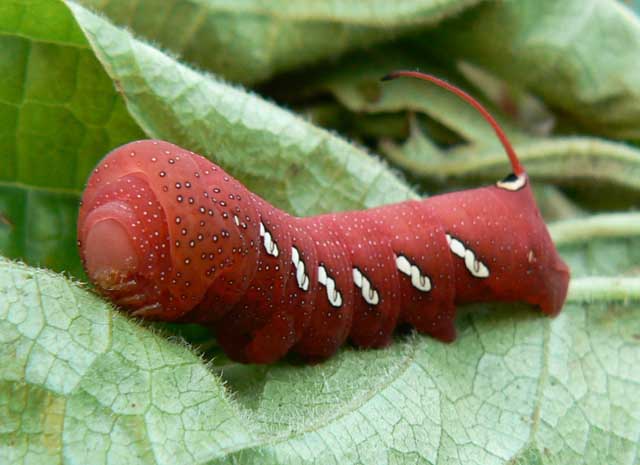
Eumorpha achemon, third or fourth instar (red-brown form), August 16,2008,
Rockport, Essex County, Massachusetts, courtesy of Kim Smith.
For care of "found larvae/caterpillars" visit Manduca sexta larva, central Texas, August 21, 2008, Trina Woodall.
Forty-one Sphingidae species are listed for Massachusetts on the U.S.G.S. website.
Not all of the species are reported or anticipated in Essex
(only two are reported on U.S.G.S.). It is hoped
that this checklist, with the thumbnails and notes, will help you
quickly identify the caterpillars you are likely to encounter.
A "WO" after the species name indicates that
I have no confirmed reports of this species in your county, but I
(William Oehlke) expect that this caterpillar is present. An * indicates the
moth is reported in Lepidoptera of North America,
#1. Distribution of Silkmoths (Saturniidae) and Hawkmoths (Sphingidae)
of Eastern North America,
an excellent little booklet available through Paul Opler.
Please help me develop this list with improved, documented accuracy by
sending sightings (species, date, location), preferably with an
electronic image, via email to Bill Oehlke.
This page is inspired by and dedicated to
Kim Smith who sent me the images of the immature Eumorpha
achemon larva featured at page top and bottom.
Kim writers, "Your website is so very thorough and we are very appreciative that it is available. I am concerned about rearing this caterpillar. I found it on the petiole of a
Virginia Creeper under an ancient apple tree on a small town lot, which gets mowed every early July. The lot is great for fresh milkweed plants at this time of year.
At first I thought it was the darker form of an Apple Sphinx, based on the description in David Wagner's Caterpillars of N.A., but now believe it is an Achemon sphinx after
looking at your website. Although this caterpillar is more reddish than the tan color you describe, both have the same interesting, vaguely, figure-eight slashes. We are
providing it with fresh apple and Virginia Creeper leaves, but he is only eating the later. Do you think I should provide the soil mixture you describe, and paper
towels above that, when he is getting ready to pupate? And then follow the directions you suggest for refrigerating in food storage bags come October?
"I realize you are probably swamped with questions, particularly at this time of year, but would greatly appreciate your advice.
"With many, many thanks and sincerely.
"P. S. Did you purchase your copy of The Hawk Moths of North America from the Wedge Entomological Research Foundation?"
I replied, "Very nice picture of third or fourth instar Eumorpha achemon.
I would like permission to post image on website.
Larvae can vary from reddish, to orange, to green or brown or even speckled.
Virginia creeper would be its host. I do not use any soil at all at pupation
time, just the loose paper towels on bottom of sandwich sized ziploc plastic
tub, like tupperware or gladware.
"Please let me know where you are located: state or province and county.
"For feeding, the foliage will hold up better if you put it in an airtight
container. You can wrap the cut ends of the creeper in a wet paper towel and
then make a tight fitting cup around that with some aluminum foil."
I am pretty sure I purchased my copy of James P. Tuttle's The Hawk Moths of North America from Bio Quip. I had phoned
Wedge Foundation first and got a recorded message, so then proceeded to place the order with Bio Quip.
Kim added, "Many, many thanks for your prompt response. I would not have had a clue as to which sphinx without your super helpful website. I would be very
happy to share images. I see that you give credit, too , which is great and I thank you!
"Also, thank you very much for the advice re paper towels and keeping foliage fresh. I have zero experience rearing caterpillars, except Monarchs, and will read the chapter in
David L. Wagner's book. The Achemon is quite large, nearly double in size since I took photo number 2; I will send a good photo before pupation. Hopefully, I will be able to
recognize the signs.
"The caterpillar was found on August 16 in Rockport, Massachusetts, which is part of Essex County. The lot where found is approximately 10,000 square feet and was
probably farmed at one time. There are two very old, but still fruit bearing, apple trees, lots of foot-high common milkweed
(A. syriaca), as the lot is mowed periodically, and an abundance of tender new Virginia Creeper shoots emerging throughout."
The caterpillar is ready to pupate when it leaves the foliage.
"We raised the caterpillar in a clear glass vase fitted with fine mesh screening, secured in place with an elastic band. Monitoring his behavior daily,
family members and visitors keenly observed his expanding heft and voracious appetite for Virginia creeper foliage. What you cannot discern from the photo is how
large he grew. By the final instar, he was as long and as round as a man’s thumb. The day before he began to pupate, he left the foliage, searching for a safe place.
We provided him with a mound of shredded paper towels to simulate underground burrows. Several times the container was jostled and he became visibly agitated.
Thereafter, we made sure he was left undisturbed, and within a week, it had become a beautiful chocolate brown pupa. We were planning to store the pupa in early
October, in a Tupperware container placed on a shelf over the stairwell of our cellar bulkhead, expecting it to eclose next spring. But much to our surprise, and
dismay, he emerged early—too early, I am afraid. Not really knowing what to do next, we placed him outdoors amongst the honeysuckle vines still flowering, as that
is one of the adult moths preferred nectar foods. He vanished. The adult wing patterning blended with the autumnal foliage."
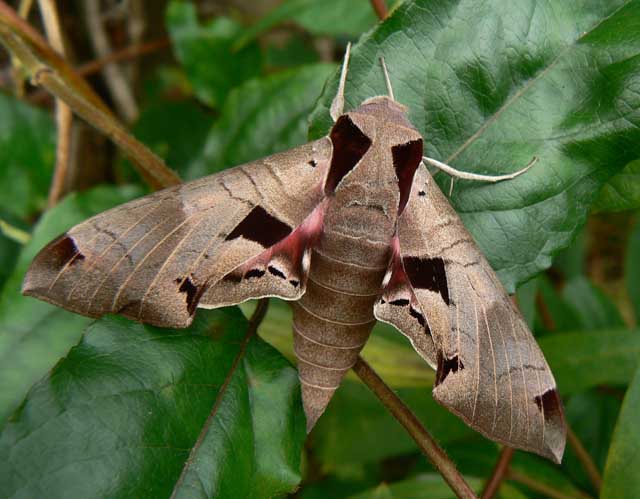
Eumorpha achemon, Rockport, Essex County, Massachusetts, courtesy of Kim Smith.
Kim Smith is an author, illustrator and designer. Preorders for her forthcoming book Oh Garden of Fresh Possibilities! ~ Notes from a Gloucester Garden,
November 2008, are available through her website at http://www.kimsmithdesigns.com and Toad Hall Bookstore at
http://www.toadhallbooks.org. Kim will be happy to respond to readers’ questions and comments at
Kim Smith.
Those species identified with MDA have been confirmed as adult moths collected in Essex County by
Matthew D. Arey. Matthew has also recorded Agrius cingulata, but that species would be a non-resident stray.
Visit Essex County Sphingidae, adult moths.
Visit Massachusetts Catocala, underwing moths.
If you are travelling, you can find active Sphingidae checklists for all coutries in North, Central, and South America and the Caribbbean via the links at
North, Central, South American Sphingidae checklists
Sphinginae subfamily
Sphingini tribe:
 |
Ceratomia amyntor
MDA,
the Elm Sphinx or Four-horned Sphinx
Caterpillars show both brown and green forms and are unmistakeable
due to four horns on the thorax (near the head).
Larvae feed on Elm (Ulmus), birch (Betula), basswood (Tilia), and
cherry (Prunus). |
 |
This caterpillar is one of the few North American Sphingidae that
feed in large groups. Colouration is distinctive. The larvae
are much more spectacular than the moths. Catalpa is the larval host. |
 |
Note the pinkish-orange tail, spiracles outlined in red and the cream
stripes on the head.
The dramatic color change from the dorsal
yellow-green to the lateral light greyish-blue is not always
as intense as in this image.
|
 |
Note the smooth skin, blue-black horn and small black spiracles.
Pawpaw is the primary host. Littleleaf sweetfern, possum haw,
inkberry, tall gallberry holly and others are also utilized.
|
 |
This caterpillar is also without the anal horn and feeds on pines.
The long stripes and reddish brown afford great camouflage.
|
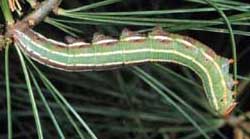 |
This caterpillar is also without the anal horn and feeds on pines.
The long stripes and reddish brown afford great camouflage.
northern range limit ??
|
 |
Note triangular bump on the thorax.
Larval hosts are various species of beebalm (Monarda), mints (Mentha), bugleweed (Lycopis),
and sage (Salvia).
|
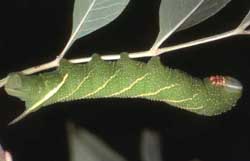 |
Larvae feed on ash in the Fraxinus genus. Syringa and Ulmus have
also been reported.
Note the black anal horn.
|
 |
Manduca quinquemaculata
MDA,
the Five-spotted Hawkmoth
Note the solid black horn and dark spiracular rings. In addition to the white
oblique lines, there are fainter white rings, especially on the back.
I suspect if you grow tomatoes, you are likely to encounter it.
|
 |
Note the red horn and black dots anterior to the white oblique lines.
If you grow tomatoes, you have probably encountered it.
|
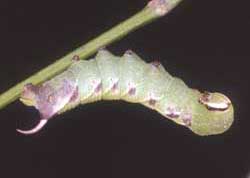
|
Sphinx canadensis
WO,
Sphinx canadensis, the Canadian Sphinx.
This species is not common at lights, and is not
often reported anywhere.
Larval host may be exclusively black ash (Fraxinus nigra).
Variable appearance but always with granulous (darker protrusions) on pinkish horn.
|
 |
Sphinx chersis
MDA,
the Northern Ash Sphinx or Great Ash Sphinx. Note pale blue horn and the creamy-white stripes on head.
The yellow form has a red horn.
Larval hosts are ash, lilac, privet, cherry and quaking aspen.
|
 |
Sphinx drupiferarum
MDA, the
Wild Cherry Sphinx.
Larvae hide in the day and feed primarily on cherry, plum, and apple
at night. Larvae have been found on Amelanchier nantuckensis
in Massachusetts and have been reared to pupation in Michigan on
Prunus serotina. Note purple oblique lines.
|
 |
Sphinx gordius
WO, the
Apple Sphinx.
Larval hosts are apple (Malus), sweetfern (Myrica),
Carolina rose (Rosa carolina), blueberry and huckleberry
(Vaccinium), white spruce (Picea glauca), American
larch (Larix laricina), and alder (Alnus).
|
 |
Sphinx kalmiae
MDA, the Laurel Sphinx.
In the final instar, the black on the head, lateral lines, horn and on abdominal
legs is diagnostic.Larvae feed primarily on lilac and fringe.
|
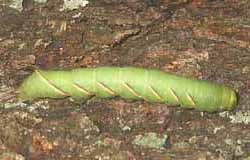 |
Sphinx luscitiosa
MDA,
the Canadian Sphinx or
Clemen's Sphinx.
This one is reported from Richmond and from northeastern New
Jersey into southern Canada.
|
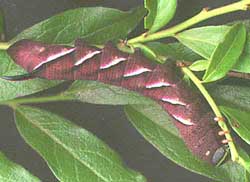 |
Sphinx poecila MDA, the Poecila Sphinx.
If you have blueberries in the woods, then you probably have the
Poecila Sphinx.
The green form is more common.
|
Smerinthini Tribe:
 |
Amorpha juglandis
MDA,
the Walnut Sphinx.
Amorpha juglandis larvae feed upon Walnut and butternut (Juglans),
hickory (Carya), alder (Alnus), beech (Fagus),
hazelnut (Corylus), and hop-hornbeam (Ostrya).
|
 |
Pachysphinx modesta
WO,
the Modest Sphinx or Poplar Sphinx.
This moth is fond
of poplars and
willows and is most likely present.
|
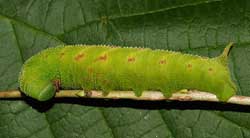 |
Paonias astylus
TM, the Huckleberry Sphinx.
It would be more common
in southern Massachusetts and is a relatively uncommon species.
Only rarely are they seen in Maine. I never saw one in New Jersey.
|
 |
Paonias excaecata MDA,
the Blinded Sphinx.
Larvae accept willows, birches, and cherries.
I have also found them in the wild on oak in eastern Canada.
|
 |
Paonias myops MDA, the Small-eyed Sphinx.
Wild cherry species are the favorites as larval foodplants, but eggs
will also be deposited on birches and other forest trees.
There are varying degrees in the amount of red markings along the sides.
|
 |
Smerinthus jamaicensis
MDA,
the Twin-spotted Sphinx.
Larvae feed upon many forest trees including birches and cherries,
but are expecially fond of poplars and willows. Red markings on sides
vary greatly from specimen to specimen.
|
 |
Smerinthus cerisyi
MDA,
Cerisy's Sphinx;
Greatly resemble modesta larvae, both being pale
green, with granular skin, pale lateral diagonal lines, faint red
spiracular circles, and very pale longitudinal lines running from the
head to a more pronounced anal diagonal line.
Larvae have green heads bounded dorsally with a pale yellow
inverted "V".
|
Macroglossinae subfamily
Dilophonotini tribe:
 |
Hemaris thysbe
MDA, the Hummingbird Clearwing
There is also an orangey-pink prepupal form. The lateral line runs
from S1 to the blue horn.
Hemaris thysbe larvae feed on viburnum and related plants.
|
 |
Hemaris diffinis
MDA, the
Snowberry Clearwing or Bumblebee Moth.
Larval host plants include Snowberry (Symphoricarpos),
honeysuckle (Lonicera), Coralberry, viburnums, Blue Dogbane
(Apocynum) and dwarf bush honeysuckle (Diervilla lonicera).
Horn is black with a yellow base.
|
 |
Hemaris gracilis MDA, the
Slender Clearwing or Graceful Clearwing.
Hemaris gracilis is distinguished from similar species by a pair of
red-brown bands on the undersides of the thorax, which varies from
green to yellow-green dorsally and sometimes brown with white
underneath. They have a red abdomen. unlikely
|
Philampelini tribe:
 |
Eumorpha achemon
MDA,
the Achemon Sphinx.
Larvae feed upon Grape (Vitis), Virginia Creeper
(Parthenocissus quinquefolia) and other vines and ivies
(Ampelopsis).
Larvae occur in both a light (green) form and darker (tan/brown/reddish)
forms. Note six "segmented" oblique lines.
|
Eumorpha achemon larva, Rockport, August 16-23, Kim Smith.
 |
Eumorpha pandorus
MDA/KS, the Pandorus Sphinx.
If you have Grape or Virginia Creeper nearby, then you might encounter
this species.Note the five large white ovals. There are orangey-brown and green
forms also.
|
Macroglossini tribe:
 |
Amphion floridensis
MDA,
the Nessus Sphinix.
In additon to Virginia creeper larvae accept Grape (Vitis),
ampelopsis (Ampelopsis), and cayenne pepper (Capsicum).
Larvae are green until the final instar.
|
 |
Darapsa choerilus
MDA, the Azalea Sphinx.
Larvae feed on Azalea and Viburnum and progress very rapidly. The
larva to the left on Viburnum cassinoides is getting ready to
pupate. Color change from green to light burgundy-brown indicates
pupation is imminent.
|
 |
Darapsa myron
MDA, the Virginia Creeper Sphinx or the
Grapevine Sphinx.
If you have the
foodplants indicated in the common names, you probably have this
species nearby. The lower wings are orange.
Larvae feed on Virginia creeper (Parthenocissus quinquefolia),
Grape (Vitis), Ampelopsis, and Viburnum.
|
 |
Darapsa versicolor
MDA,
the Hydrangea Sphinx.
Larvae feed on Smooth hydrangea (Hydrangea arborescens),
buttonbush (Cephalanthus occidentalis), and waterwillow
(Decodon verticillatus).
Note small head which can be retracted into the thorax.
|
 |
Deidamia inscriptum
MDA,
the Lettered Sphinx.
Grape (Vitis), ampelopsis (Ampelopsis), and
Virginia creeper (Parthenocissus) all serve as larval hosts.
The alternating yellow and greyish-green rings across the back
distinguish this larva.
|
 |
Hyles gallii
MDA/SF, the Bedstraw Hawk Moth
or Gallium Sphinx.
Larvae come in black and in brown forms and often feed on
Epilobium (fireweed).
|
Hyles gallii adult moth, September 5, 2018, Sissy Ffolliott
 |
Hyles lineata
MDA, the White-lined Sphinx.
Larvae are highly varied and feed on a great diversity of plants
including willow weed (Epilobium), four o'clock (Mirabilis),
apple (Malus), evening primrose (Oenothera), elm
(Ulmus), grape (Vitis), tomato (Lycopersicon),
purslane (Portulaca), and Fuschia.
All larvae seem, however, to have the red/black swellings split by
dorso-lateral lines.
|
 |
Sphecodina abbottii
MDA,
the Abbott's Sphinx.
Larvae feed at night on grape (Vitis) and ampelopsis
(Ampelopsis) and hide on the bark of their host plants during
the day. Virginia creeper would also be a suitable host. There is also a dark form
without the green patches. Note the "raised eye", replacing the anal horn.
|
|
|
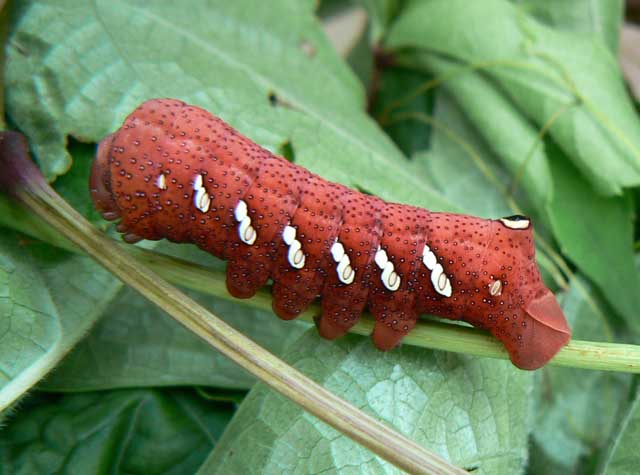
Eumorpha achemon, fifth instar (red-brown form), August 22, 2008,
Rockport, Essex County, Massachusetts, courtesy of Kim Smith.
Use your browser "Back" button to return to the previous page.
This page is brought to you by
Bill Oehlke and the
WLSS. Pages are on space rented from Bizland. If you would like
to become a "Patron of the Sphingidae Site", contact Bill.
Please send sightings/images to Bill. I will do my best to respond to
requests for identification help.
Enjoy some of nature's wonderments, giant silk moth cocoons. Cocoons of the local Saturniidae
are sold and shipped while in a dormant state in the fall and winter. Beautiful giant silk moths emerge in spring and summer. Online help is available.
 | 
Show appreciation for this site by clicking on flashing butterfly to the left.
The link will take you to a page with links to many insect sites. |



